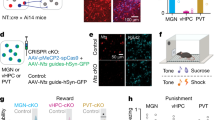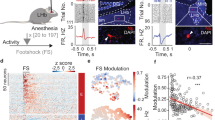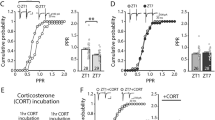Abstract
The cellular basis of depressive disorders is poorly understood1. Recent studies in monkeys indicate that neurons in the lateral habenula (LHb), a nucleus that mediates communication between forebrain and midbrain structures, can increase their activity when an animal fails to receive an expected positive reward or receives a stimulus that predicts aversive conditions (that is, disappointment or anticipation of a negative outcome)2,3,4. LHb neurons project to, and modulate, dopamine-rich regions, such as the ventral tegmental area (VTA)2,5, that control reward-seeking behaviour6 and participate in depressive disorders7. Here we show that in two learned helplessness models of depression, excitatory synapses onto LHb neurons projecting to the VTA are potentiated. Synaptic potentiation correlates with an animal’s helplessness behaviour and is due to an enhanced presynaptic release probability. Depleting transmitter release by repeated electrical stimulation of LHb afferents, using a protocol that can be effective for patients who are depressed8,9, markedly suppresses synaptic drive onto VTA-projecting LHb neurons in brain slices and can significantly reduce learned helplessness behaviour in rats. Our results indicate that increased presynaptic action onto LHb neurons contributes to the rodent learned helplessness model of depression.
This is a preview of subscription content, access via your institution
Access options
Subscribe to this journal
Receive 51 print issues and online access
$199.00 per year
only $3.90 per issue
Buy this article
- Purchase on SpringerLink
- Instant access to full article PDF
Prices may be subject to local taxes which are calculated during checkout




Similar content being viewed by others
References
Krishnan, V. & Nestler, E. J. The molecular neurobiology of depression. Nature 455, 894–902 (2008)
Matsumoto, M. & Hikosaka, O. Lateral habenula as a source of negative reward signals in dopamine neurons. Nature 447, 1111–1115 (2007)
Matsumoto, M. & Hikosaka, O. Representation of negative motivational value in the primate lateral habenula. Nature Neurosci. 12, 77–84 (2009)
Hikosaka, O. The habenula: from stress evasion to value-based decision-making. Nature Rev. Neurosci. 11, 503–513 (2010)
Ji, H. & Shepard, P. D. Lateral habenula stimulation inhibits rat midbrain dopamine neurons through a GABAA receptor-mediated mechanism. J. Neurosci. 27, 6923–6930 (2007)
Nestler, E. J. & Carlezon, W. A., Jr The mesolimbic dopamine reward circuit in depression. Biol. Psychiatry 59, 1151–1159 (2006)
Krishnan, V. et al. Molecular adaptations underlying susceptibility and resistance to social defeat in brain reward regions. Cell 131, 391–404 (2007)
Mayberg, H. S. Targeted electrode-based modulation of neural circuits for depression. J. Clin. Invest. 119, 717–725 (2009)
Sartorius, A. et al. Remission of major depression under deep brain stimulation of the lateral habenula in a therapy-refractory patient. Biol. Psychiatry 67, e9–e11 (2010)
Maier, S. F. Learned helplessness and animal models of depression. Prog. Neuropsychopharmacol. Biol. Psychiatry 8, 435–446 (1984)
Henn, F. A. & Vollmayr, B. Stress models of depression: forming genetically vulnerable strains. Neurosci. Biobehav. Rev. 29, 799–804 (2005)
Schulz, D., Mirrione, M. M. & Henn, F. A. Cognitive aspects of congenital learned helplessness and its reversal by the monoamine oxidase (MAO)-B inhibitor deprenyl. Neurobiol. Learn. Mem. 93, 291–301 (2010)
Porsolt, R. D., Le Pichon, M. & Jalfre, M. Depression: a new animal model sensitive to antidepressant treatments. Nature 266, 730–732 (1977)
Lecourtier, L. & Kelly, P. H. A conductor hidden in the orchestra? Role of the habenular complex in monoamine transmission and cognition. Neurosci. Biobehav. Rev. 31, 658–672 (2007)
Jhou, T. C. et al. The rostromedial tegmental nucleus (RMTg), a GABAergic afferent to midbrain dopamine neurons, encodes aversive stimuli and inhibits motor responses. Neuron 61, 786–800 (2009)
Kaufling, J. et al. Afferents to the GABAergic tail of the ventral tegmental area in the rat. J. Comp. Neurol. 513, 597–621 (2009)
Zucker, R. S. & Regehr, W. G. Short-term synaptic plasticity. Annu. Rev. Physiol. 64, 355–405 (2002)
Sartorius, A. & Henn, F. A. Deep brain stimulation of the lateral habenula in treatment resistant major depression. Med. Hypotheses 69, 1305–1308 (2007)
Airan, R. D. et al. High-speed imaging reveals neurophysiological links to behavior in an animal model of depression. Science 317, 819–823 (2007)
Berton, O. & Nestler, E. J. New approaches to antidepressant drug discovery: beyond monoamines. Nature Rev. Neurosci. 7, 137–151 (2006)
Pittenger, C. & Duman, R. S. Stress, depression, and neuroplasticity: a convergence of mechanisms. Neuropsychopharmacology 33, 88–109 (2008)
Sahay, A. & Hen, R. Adult hippocampal neurogenesis in depression. Nature Neurosci. 10, 1110–1115 (2007)
Mill, J. & Petronis, A. Molecular studies of major depressive disorder: the epigenetic perspective. Mol. Psychiatry 12, 799–814 (2007)
Morris, J. S. et al. Covariation of activity in habenula and dorsal raphe nuclei following tryptophan depletion. Neuroimage 10, 163–172 (1999)
Roiser, J. P. et al. The effects of tryptophan depletion on neural responses to emotional words in remitted depression. Biol. Psychiatry 66, 441–450 (2009)
Shumake, J. & Gonzalez-Lima, F. Brain systems underlying susceptibility to helplessness and depression. Behav. Cogn. Neurosci. Rev. 2, 198–221 (2003)
Caldecott-Hazard, S., Mazziotta, J. & Phelps, M. Cerebral correlates of depressed behavior in rats, visualized using 14C–2-deoxyglucose autoradiography. J. Neurosci. 8, 1951–1961 (1988)
Amat, J. et al. The role of the habenular complex in the elevation of dorsal raphe nucleus serotonin and the changes in the behavioral responses produced by uncontrollable stress. Brain Res. 917, 118–126 (2001)
Yang, L. M. et al. Lateral habenula lesions improve the behavioral response in depressed rats via increasing the serotonin level in dorsal raphe nucleus. Behav. Brain Res. 188, 84–90 (2008)
Winter, C. et al. Pharmacological inhibition of the lateral habenula improves depressive-like behavior in an animal model of treatment resistant depression. Behav. Brain Res. 216, 463–465 (2011)
Rumpel, S., LeDoux, J., Zador, A. & Malinow, R. Postsynaptic receptor trafficking underlying a form of associative learning. Science 308, 83–88 (2005)
Kopec, C. D. et al. Glutamate receptor exocytosis and spine enlargement during chemically induced long-term potentiation. J. Neurosci. 26, 2000–2009 (2006)
Kopec, C. D., Real, E., Kessels, H. W. & Malinow, R. GluR1 links structural and functional plasticity at excitatory synapses. J. Neurosci. 27, 13706–13718 (2007)
Vollmayr, B. & Henn, F. A. Learned helplessness in the rat: improvements in validity and reliability. Brain Res. Brain Res. Protoc. 8, 1–7 (2001)
Acknowledgements
We thank K. Deisseroth for help and suggestions, A. Gifford and A. Biegon for sharing equipment and laboratory space, and members of the Malinow Lab and Li Lab for discussions. This study was supported by the Dana Foundation (B.L.), the Biobehavioral Research Awards for Innovative New Scientists (BRAINS) from the National Institute of Mental Health, National Institutes of Health (1R01MH091903-01) (B.L.) and the Shiley-Marcos Endowment (R.M.).
Author information
Authors and Affiliations
Contributions
B.L., J.P., M.M. and C.C contributed equally to the study. B.L., J.P., M.M., C.C., C.D.P. and D.S. performed and analysed the experiments. C.C. and B.L. made the figures. B.L., F.H. and R.M. designed the study. B.L. and R.M. wrote the manuscript.
Corresponding authors
Ethics declarations
Competing interests
The authors declare no competing financial interests.
Supplementary information
Supplementary Figures
The file contains Supplementary Figures 1-5 with legends. (PDF 7529 kb)
Rights and permissions
About this article
Cite this article
Li, B., Piriz, J., Mirrione, M. et al. Synaptic potentiation onto habenula neurons in the learned helplessness model of depression. Nature 470, 535–539 (2011). https://doi.org/10.1038/nature09742
Received:
Accepted:
Published:
Issue Date:
DOI: https://doi.org/10.1038/nature09742



